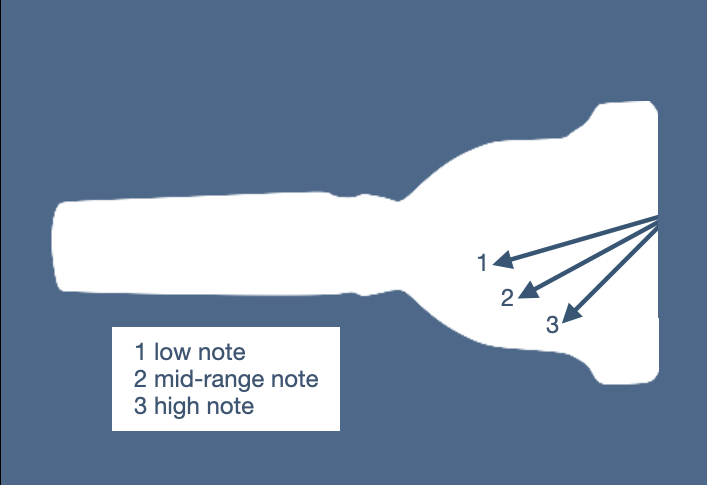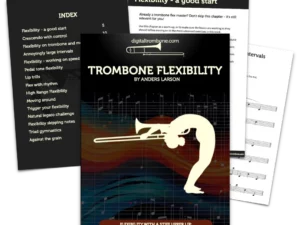
How to aim your airflow correctly and large intervals target practicing
92,6% of trombone playing is about effortlessly hitting the desired note. You should be able to do this with a soft but still responsive and precise attack. Sounds easy, and some players just do it right without ever speculating on how they do it. That’s great – until the day when things for some reason stop working. Then you might be stranded without the knowledge of how to fix your chops and get back on track.
I have been there, and it is not a pleasant place to be. But it has taught me lots of valuable lessons that I pass on to you. Here is one key giveaway.
Aim the air into the mouthpiece
You need to make embouchure adjustments for high range and low range, and one of the most important factors is how you direct the airflow into your mouthpiece.

The blue arrows symbolize air that passes between your soft lips into the mouthpiece and transforms into beautiful trombone music.
In the low register, you should aim the air slightly below the middle of the mouthpiece. I do this mostly with my lower lip, shaping it to direct the air upwards towards the center and moving the lower lip just so slightly outwards. Try saying the word LOW out loud. That wovel helps you shape your lower lip correctly.
In the high register, you should aim the air further down in the mouthpiece. The higher the pitch, the lower you aim the air. I do this with the same wovel as in the low register, but I use the upper lip to guide the air downwards, extending the upper lip out a little bit.
It might sound counterintuitive to aim air higher to play low notes and vice versa, but this is how you do it. Without guiding the airstream correctly, your sound will not be as clear and open, and you can end up compensating with air pressure and tensions within your body.
In practice
You can (and should) apply this technique to all aspects of your trombone playing. If you want to be laser-targeted when practicing this, I made a specific exercise for it called Large intervals target practicing. It is found in the member’s section, and you can access it for free by starting your free trial. Once you get accustomed to this way of thinking and playing, you will find that playing large intervals is not hard!
Don’t forget the cavity of your mouth
Aiming the air is not all you need to change when going from low to high range. You also need to adjust the cavity of your mouth, using a large cavity and keeping the tongue low when playing low notes. When playing high notes your tongue will be lifted and the cavity of your mouth smaller.
Regardless of the range, you should keep your throat open and let the air flow freely. When playing from the low range to the high range, you should rather try to open your throat even more (while making the cavity of your mouth smaller) to ensure you don’t narrow it by reflex to hit those high notes.
NEVER change pitch with air force or air pressure from your diaphragm. That part of your body will tag along just fine as long as you make sure the embouchure is correct. just turn on the air supply and play with your embouchure.
Good luck with your trombone playing!
Anders Larson, founder of digitaltrombone.com






